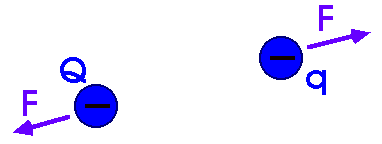

The Electric Force: Coulomb's Law Remember, UNLIKE charges attract,

or
and LIKE charges repel,

or
What determines the magnitude of this electric force F?
The force F is directly proportional to the charges Q and q,
F Q q
The force F is inversely proportional to the square of the distance r between the charges,

F
1 / r2
F
1 / r2
F
1 / r2
We can combine these as
F Q q / r2
While proportionalities are good for qualitative discussions and comparisons, equations are much easier to use for calculations. We can change this to an equation with a constant of proportionality, k.
F = k Q q / r2 This constant of proportionality, k, depends upon the units we use. If we measure force F in newtons (N), distance r in meters (m), and charges Q and q in coulombs (C), then k has a value of
k = 9 x 109 N m2/C2 Now we must ask, just what is a coulomb of charge, anyway?
The electric charge of an electron or a proton is labeled e and is equal to . . .
Coulomb's Law describes the force F between two electric charges, Q and q, a distance r apart,
What is the force between two positive charges, 1
C and 2
C, when they are separated by a distance of 1 m?
(c) Doug Davis, 2002; all rights reserved
Return to Ch 17, Electrostatics & Electric Energy